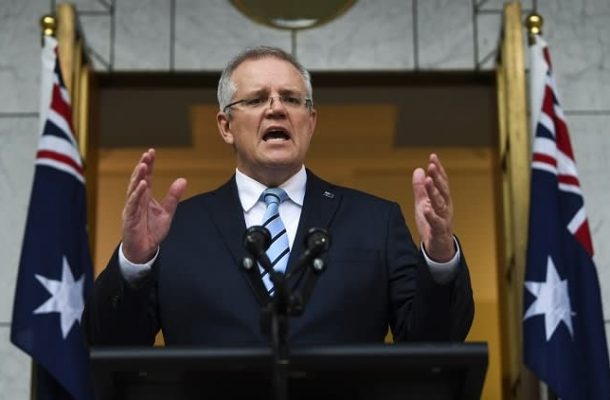Holding politicians to account

Prime Minister Scott Morrison stands, flanked by Australian flags, in front of the double doors and cool-grey bricks of Parliament House in Canberra. The courtyard scene is familiar – it’s the backdrop to the announcement of federal elections; where prime ministers have faced down leadership challenges from their rivals; or emotionally resigned from office.
It’s 8 May, and Morrison is giving one of his regular press conferences updating Australians on the COVID-19 pandemic. There’s a lectern in front of him, and the Chief Medical Officer is by his side.
In one hand, the PM holds a large piece of paper – the “roadmap” to recovery. All we need to do, he reassures, is continue to “pull together” and focus “on something bigger than just ourselves”. In front of him gather the appropriately-distanced members of the parliamentary press gallery.
“The National Cabinet met this morning …”
The press conference has emerged as a central communication tool during the COVID-19 pandemic, offering national political leaders a way to reach out to citizens. In Australia and the US, the countries where my research is focused, Scott Morrison and Donald Trump have held press conferences or “briefings” multiple times a week, if not daily, since mid-February.
The goal? To seize the day’s news agenda, and communicate the most recent decisions of Australia’s National Cabinet or of the US’ Coronavirus Task Force.
The proliferation of communication platforms in the current era, from TV to TikTok, has some democratic benefits. It opens up ways for leaders to communicate with citizens, and through which citizen voices animate public discourse.
However, this proliferation also contributes to fragmenting of the spaces in which societies debate issues of shared concern. As the number of platforms, providers and technologies multiply, false and misleading information spreads quickly, and becomes even more difficult to effectively counteract.
This is a significant challenge for governments seeking to provide clarity in a moment of crisis, and for leaders seeking to unite and mobilise citizens.
In the first half of 2020, the COVID-19 pandemic has dominated political news cycles. The speed and severity with which it emerged has brought about change across many areas of daily life. In response, political leaders stand in front of news cameras and webcams, and appeal to citizens to shift their own behaviour to support the wellbeing of a national community whose membership has always been contingent and politically constructed.

In more than 100 press conferences, speeches and interviews since mid-February, the Prime Minister has evoked familiar images of Australian identity. These call on ostensibly shared understandings of who “we” are as a nation. In Morrison’s language, Australians are “punching above our weight” internationally in the success of our response. We’re working together, rising to the challenges of a “battle” that the Prime Minister has consistently framed as waged on both health and economic fronts.
This is how political communication works in a time of crisis, be it conflict, recession or pandemic. Notions of national identity that appeal to our “best selves” (and set aside any exclusionary faultlines) are put to work in political communication to inspire action.
This unproblematically positive version of Australian identity – founded on mateship, hard work and optimism – is seen as our greatest resource. As the Prime Minister reassured Australians in a press conference on 14 May, they should be hopeful “on the basis of our national character and our ingenuity and our resolution that we will see those better days…”.
“Notions of national identity that appeal to our “best selves” (and set aside any exclusionary faultlines) are put to work in political communication to inspire action.”
Central elements of this strategy are also echoed in US President Donald Trump’s press conferences. The President speaks from the White House press briefing room, the Rose Garden, or the South Lawn with Marine One in the background.
He reminds Americans frequently and triumphantly (if rarely accurately) that their response to COVID-19 is leading the world: in the number of tests and ventilators; the state of the economy before the pandemic; and the rate at which that economy would be rebuilt. “Every American,” he argued at the start of a Rose Garden press briefing on 11 May, “should be proud of the amazing array of talent, skill and enterprise our nation has brought to this challenge.”

Say hello to the fake news
These claims of success, and images of national identity on which they rest, are not communicated in a vacuum. In both Australia and the US, political journalists are highly visible players in the regular COVID-19 briefings, and the pandemic has revealed just how vital a role they play.
The past two decades have seen the ability of political reporters to perform their traditional democratic role as the eyes and ears of the people, and watchdog over the powerful, complicated by intersecting crises. These include a crisis of trust in journalism, and a crisis of funding and business models, leading to contractions and closures in traditional and digital newsrooms.
Responding to these has led to innovation and introspection, and attempts to reassert the value and authority of political journalism. It’s seen the rise of fact-checking in Australia, some now directed at countering COVID-19 misinformation.
The live broadcasts, livestreams and coverage of press conferences has showcased the role of political reporters in asking questions and seeking clarification, ensuring these events do not simply become opportunities for flag-waving about national progress.
In Australia, ABC political editor Andrew Probyn’s follow up questions about social distancing in a press conference in March led to a terse exchange with the Prime Minister (and to Probyn’s emergence as the unlikely subject of memes on the social video-sharing platform TikTok).
In the US, the President’s hostile treatment of the press has been on frequent display in the past few months, in both routine and more remarkable moments of criticism.
On 13 May, for example, the President opened a press conference in the Cabinet Room by asking the governors and senators joining him to “say hello to the fake news”. He then criticised the journalists because they “just don’t want to print” his claim that the US’ COVID-19 testing rate put it ahead of other countries. The fractured relationship between the Trump administration and White House press corps is also evident in the President’s dislike of follow-up questions, or those he perceives to be critical.
These press conferences achieve a number of goals simultaneously. They’re information-sharing exercises, offering updates on COVID-19 case numbers, regulations, and relief packages. They offer reassurance in a time of great uncertainty through evocations of collective purpose and shared identity.
Importantly, as impact of the pandemic deepens the long-term financial woes of the news media in both Australia and the United States, they provide a timely reminder of the vital work of political journalism in democracies: to ask challenging questions; to counter the spread of false or misleading information; and to probe the boundaries, limits and priorities of the national collective.
Whether this leads to a renewed public appreciation in Australia for the role of political journalism in holding those in power to account, as it has elsewhere, remains to be seen.
This article was published by Lens.
Stephanie teaches journalism studies at Monash University. She was previously a lecturer in the media and communications program at the University of Melbourne.













